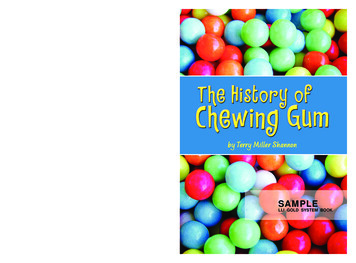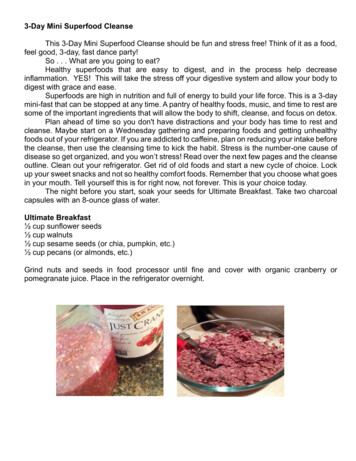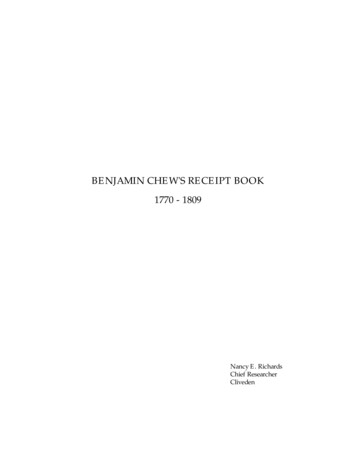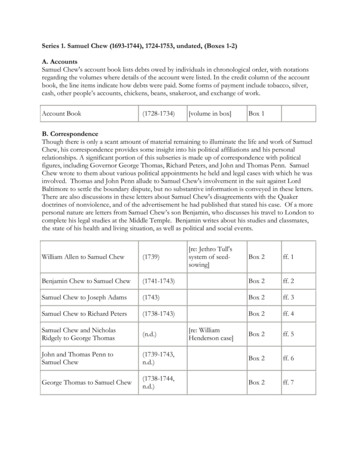
Transcription
The History ofA Good ChewChewing GumChewing gum seems like a modernhabit, so it’s surprising to learn thatpeople have been chewing sometypes of gum for thousands of years.Discover the history of gum chewing,and explore the reasons why chompingon gum has stood the test of time.by Terry Miller ShannonSAMPLELLI GOLD SYSTEM BOOKNonfiction: Narrative NonfictionBook 149 Level S1267 Total Running WordsLLI 1102 G HistoryGum C PPDF-SAMPLE.indd 2-3ISBN-13: 978-0-325-03678-6ISBN-10: 0-325-03678-01/16/13 10:04 AM
The History ofChewing Gumby Terry Miller ShannonTABLE of CONTENTSA Chewy Discovery . . . . . . . . . . . . . .2Ancestors Chomping Around the World . . .4Oops! . . . . . . . . . . . . . . . . . . . . .7Improving the Recipe . . . . . . . . . . . . . 11Why Chew? . . . . . . . . . . . . . . . . . . 14Key Dates in Chewing Gum History . . . . . 15Glossary . . . . . . . . . . . . . . . . . . . . 16SAMPLELLI GOLD SYSTEM BOOKLLI 1102 G HistoryGum I PPDF SAMPLE.indd 11/16/13 10:07 AM
A Chewy DiscoveryGum chewing might be a forbidden practice in yourschool, but people have been chewing gum all over theworld for thousands of years. In fact, scientists have proofthat people chewed gum in Finland about 5,000 years ago!And they weren’t the only gum chewers of early times.Ancient Greeks, native peoples of Central and NorthAmerica, and American pioneers also chewed gum. Pictureit: Greeks draped in cloaks, Native Americans paddlingcanoes, and trail-making pioneers . . . all with wads of gumin their mouths.Archeology student Sarah Pickin made the gumdiscovery in Finland in 2007. She discovered a 5,000-yearold blob of bark tar from a birch tree while working on adig in western Finland. Pickin and the other archeologistsworking on the dig grew excited when they noticed toothprints in the tar. They suspected someone might havechewed the tar in the same way we chew on bubblegum today.Ancient Disease PreventionScientists say that the type of tar SarahPickin found in Finland actually kills sometypes of germs when it’s chewed. Theancient gum chewers in Finland may havebeen chewing the tar to treat or preventmouth infections caused by these germs.Long ago in Finland,people sometimesused this birch barktar gum as glue tofix broken pots.2LLI 1102 G HistoryGum I PPDF SAMPLE.indd 21/16/13 10:07 AM
Today, people chew gum for many reasons. Manypeople like the taste of gum or the action of chewing.Others hope it will keep their teeth healthy. Some gumchewers may have noticed what some scientific studies haveshown—that gum chewing makes people more alert andimproves their memory. The gum we chew today, however,is quite different from what people chewed long ago.Gu m Che wing by Cou n t r yAverage Number of PiecesEach Person Eats in a StatesUnitedKingdomTaiwanRussiaChinaCountryGum Chewing Around the WorldSAMPLEAround the world, people chew aboutLLI 560,000GOLD SYSTEM BOOKtons (508,023 metric tons) of gum each year.Americans chew an average of 170 to 180pieces a year. See how that amount compares3to the amounts of people around the world.LLI 1102 G HistoryGum I PPDF SAMPLE.indd 31/16/13 10:07 AM
Ancestors ChompingAround the WorldGum chewers of the past found their chewable material inlocal plants. Ancient Greeks chewed the sweet-tasting resin(REZ-in) of a local plant called the mastic (MAS-tik) tree.They took the gooey, yellowish resin from sap found inthe tree’s bark. The Greeks chewed mastic gum to sweetentheir breath and to clean their teeth.Ancient Greeks chewedmastic resin and alsoused it for cooking andas medicine.4LLI 1102 G HistoryGum I PPDF SAMPLE.indd 41/16/13 10:07 AM
Maya Indians living in Central America during the years100 to 200 enjoyed a type of gum, too. They chewedchicle (CHIK-uhl), a natural gum taken from the sapodilla(sap-uh-DIL-uh) tree. This tree grows mainly in parts ofMexico, Guatemala, and Belize.Spruce trees provided gum to natives in North America.Native Americans found chewable resin when they cut intospruce bark. In the seventeenth century, they taught earlysettlers to chew this resin gum to clean their teeth andfreshen their breath.Where Sapodilla Trees GrowYUCATANPENINSULAMEXICOGUATEMALABelizeSAMPLELLI GOLD SYSTEM BOOKThe green area on the map shows where sapodillatrees grow. Sapodilla trees are the source of chicle.5LLI 1102 G HistoryGum I PPDF SAMPLE.indd 51/16/13 10:07 AM
The settlers adopted the gum-chewing habit as theirown. Some chewers decided they might be able to makemoney with the gum. They sold and traded lumps ofspruce resin. Lumberjacks working in forests also collectedand sold spruce resin.Spruce resin gum was popular until the 1850s when anew chewing craze began. There were fewer spruce treesto use as a source of gum, so some creative gum loverdecided to sweeten paraffin (PAR-uh-fin) wax, which wasused in candles. As a gum, this wax had its drawbacks.Paraffin wax gum is stiff and hard to chew until it warmsup. It was inexpensive to make, though, and it becamemore popular than resin gum.If you’ve tried to chewwax lips, you know whyparaffin wax gum fellout of favor with gumchewers of long ago.6LLI 1102 G HistoryGum I PPDF SAMPLE.indd 61/16/13 10:07 AM
Oops!Then, one man’s mistake produced a better chewing gum.A Mexican general named Antonio Lopez de Santa Annaneeded money. He decided he could make it by sellingchicle, and he convinced an American inventor namedThomas Adams that chicle could be made into tires.It was 1869 and people needed tires for their carriages.Chicle was cheap and the rubber usually used to maketires was very expensive. Santa Anna and Adams thoughtthey would make a fortune if Adams could make a rubbersubstitute out of chicle.Horses pulled carriages like this one in thelate nineteenth century. Rubber tires helpedto soften the ride for passengers.SAMPLELLI GOLD SYSTEM BOOK7LLI 1102 G HistoryGum I PPDF SAMPLE.indd 71/16/13 10:07 AM
Santa Anna handed Adams a knob of gray chiclecovered in bark and rocks. Soon after, Adams bought abouta ton more of chicle to use in experiments. Adams and hisfamily tried for a year to make something like rubber fromthe chicle. They had no luck. Chicle, it turned out, was nota good material to use to make tires.Then one day Adams was in a drugstore. He watched agirl buy a penny’s worth of chewing gum. The shopkeepertold Adams the gum he sold was made of paraffin wax,and that it was not good to chew. Adams immediatelythought of all the chicle he had left at home from hisfailed tire experiments. Perhaps he could use the chewysubstance to make and sell a better type of gum.Chicle to Chewing ngMixing bladeHot airFlameGum base8LLI 1102 G HistoryGum I PPDF SAMPLE.indd 81/16/13 10:07 AM
Adams began to experiment with the chicle once again.Soon, he found that the dried resin would not dissolve inwater, which meant it wouldn’t dissolve inside a person’smouth, either. He molded pieces of chicle into balls—thefirst gumballs—and began selling them.Soon drugstores wanted more. This time, Adams moldedthe gum into sticks and wrapped them in tissue paper. Hisgum business was ready to take off.Chicle is a naturalgum that comes fromthe sapodilla tree.RollingSAMPLELLI GOLD SYSTEM BOOK9LLI 1102 G HistoryGum I PPDF SAMPLE.indd 91/16/13 10:07 AM
The gum sold so well that Adams patented his gum asAdams New York Chewing Gum. He invented a machine tomix the gum and form it into sticks. He added flavors tohis chewy chicle base. When he added shreds of licorice tochicle, it turned black. You can still buy a modern versionof Adams’ Black Jack gum today.,James D. Julia, IncPhoto courtesy ofulia.comesjamw.jww,ME,Auctioneers, FairfieldThomas Adams invented thefirst gum vending machinein 1888. He filled it withgumballs and placed it on aNew York City train platform.10LLI 1102 G HistoryGum I PPDF SAMPLE.indd 101/16/13 10:08 AM
Improving the RecipeAdams’ gum company was doing well. Other businesspeopledecided they could improve on the gum recipe and makemoney themselves. Each entrepreneur added something new.John Colgan owned a drugstore in the United States.When Colgan mixed up a batch of gum, he addedpowdered sugar and a spicy sap called tolu (taw-LOO).Taffy-Tolu Chewing Gum was very popular around 1880.More people continued to tinker with the gum recipe.American Edward Beeman invented a gum that wassupposed to help stomachaches. Beeman’s Chewing Gum isstill on the market, although the recipe has changed.John Colgan addedsugar and spicysap to his chewinggum in the latenineteenth century.SAMPLELLI GOLD SYSTEM BOOK11LLI 1102 G HistoryGum I PPDF SAMPLE.indd 111/16/13 10:08 AM
Inventor William White’s ideas are still in style today.He invented mint gum in 1880, which was a big hit in hishome state of Ohio.Frank Fleer made an early bubble gum called “BlibberBlubber.” It had a great name, but it wasn’t a great gum. Ittasted all right and could be chewed to blow bubbles, butit sometimes stuck to people’s skin and clothes. It stuckso badly that it had to be removed with chemicals usuallyused to remove paint.Walter Diemer made a better bubble gum in 1928.It happened when he was testing recipes for gum whileworking for Fleer’s company. He accidentally created onebatch of gum that could be chewed and expanded intobubbles easily and safely. Diemer also figured out a way tocolor the gum pink. This was a big step in gum chewinghistory . . . pink bubble gum that did not stick to your skinor your clothes!A worker watches overproduction at a chewinggum factory.12LLI 1102 G HistoryGum I PPDF SAMPLE.indd 121/16/13 10:08 AM
How G um Is Made TodayToday, gu m is made using thes e steps:1A man-made gu m ba se(a chewy su bs tance thatha s nonu tr ition) is melted.2 The ba se is pour ed in to a mixer. Sweeten er s and flavor sar e mixed in to the ba se.3 The blob ofgu m go es throug h rollers that mold it in to athin, wide ri bbon.4 Powdered sugar or another sweeteneris added to keep thegu m fr om sticking to itself or to a gu m chewer's mou th.5 The gu m ismoved to a place to cool.6 The ri bbon ofgu m is cu t in to pieces.7 The gu m iswrapped by a wrappingmachine.SAMPLELLI GOLD SYSTEM BOOK13LLI 1102 G HistoryGum I PPDF SAMPLE.indd 131/16/13 10:08 AM
Why Chew?If you think about it, chewing gum doesn’t really makesense. Why would people chew something without eatingit or swallowing it? We chew gum for many reasons.Some people like the taste. Some find that they are notas thirsty when they chew gum. Dentists also say thatchewing sugarless gum might help prevent cavities bycausing more saliva to wash over teeth.Scientists are interested in the question of why peoplechew gum. They’ve discovered that people who chewgum feel more alert and remember things better. In 2009,scientists studied more than 100 eighth-graders for fourteenweeks. One group chewed gum while they studied mathand took math tests. The other group didn’t chew gum.The gum-chewing students had better test scoreson math tests than the non-chewers. Maybethis is a sign that chewing gum in schoolshouldn’t be against the rules anymore.After all, if people have been chewing formore than 5,000 years, there must besomething to it!14LLI 1102 G HistoryGum I PPDF SAMPLE.indd 141/16/13 10:08 AM
Key Dates inChewing GumHistoryAbout 3,000 b.c.People in Finland chewbirch bark tar.About 450 b.c.Greeks chew mastic resin.About 101–200 a.d.Mayans in Central Americachew chicle.About 1600Natives of North America chewspruce resin and introduce itto settlers.About 1850People chew sweetenedparaffin wax.1869Thomas Adams marketsflavored chicle.1871Thomas Adams invents thefirst gum-manufacturingmachine.1880William White addspeppermint flavor to gum.1888Adams begins selling gum froma vending machine.1906Frank LLIFleerGOLDinventsSYSTEMthe first BOOKbubble gum, Blibber-Blubber.1928Walter Diemer invents abetter bubble gum.SAMPLE15LLI 1102 G HistoryGum I PPDF SAMPLE.indd 151/16/13 10:08 AM
Glossaryarcheologist a scientist who studies past human life and activitiesarcheology the study of past human life and activitieschicle a natural gum that comes from the sapodilla treeentrepreneur businesspersonmastic the resin from the bark of the mastic treeparaffin a white, waxy material used to make candlesresin a sticky material that oozes from treessapodilla a large evergreen tree that grows in Mexico andCentral Americatolu a strong-smelling liquid from an American tree16LLI 1102 G HistoryGum I PPDF SAMPLE.indd 161/16/13 10:08 AM
A Good Chew ISBN-13: 978-0-325-03678-6 ISBN-10: 0-325-03678-0 Nonfiction: Narrative Nonfiction Book 149 Level S 1267 Total Running Words SAMPLE LLI GOLD SYSTEM BOOK LLI_










